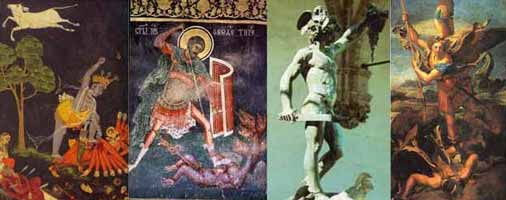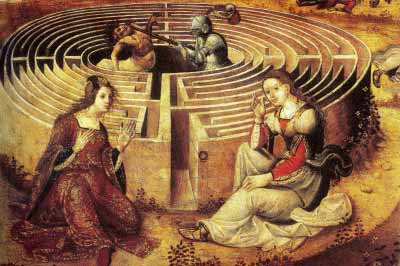 Gnosis and Gnosticism
Gnosis and Gnosticism  The Practice of Gnosis
The Practice of Gnosis
The Practice of Gnosis |

|

|
| Written by Editor VOPUS | |

In trying to answer the questions of existence, the modern man usually turns his searches first towards the exterior. He reads various authors, various esoteric or pseudo-esoteric books, attending eventually the classes of some schools that promise to bring the light. Often they do nothing but increase his confusion. Nowadays, the human being faces an avalanche of pseudo-occultist information of all kind, each trying in its own way to answer some questions. This is because unfortunately these theories are mostly the fruit of an intellectual work. Erudition without experimentation leads us only to conflicts, to the battle of the antithetical concepts. The present moral and spiritual chaos is the fruit of the intellect wrongly utilized. Today in the world can be seen two opposite trends, of great force, struggling for supremacy. On one hand the spiritualist trend encompassing the mystical dogmatic trends, the religious doctrines, all those who denied the material world and closed themselves in mystical ideas, and on the other hand the materialistic trend soaked in intellectual theories more or less rigid, which leaves no room for any flavor of spirituality. The spiritualist trend believe that it has the truth, and inside of it each theory of a spiritual nature also believes it has the truth, the secrets of creation and the keys of heaven. The materialist-atheists also believe eagerly that they have the answers and that everything is guided by their theories, that they can control and even direct how things work in creation. The spiritualist trend worships The God-Spirit, no matter what name is given: Alah, Brahma, God etc. The materialist trend worships The God-Matter, also regardless of what name is given. The fanatics of spiritualism and of materialism have filled the world with theories, hypotheses and suppositions that they were never experimented. Who is right? 
We could say that neither one, nor the others are right for the simple reason that theory lacks the direct experience of what is truly superior. The theories have become tiresome, are sold and resold on the market, make promises they cannot keep. The trial, the probation, the exclusively tridimensional demonstration is not total, integral. There are millions of theories and thousands of authors. Some repeat the ideas of others. Others fight against these ones, all against one and one against all; between colleagues are banters and fights against each other, one against another, and all, really, against all. The reader must thus drink the bitter cup of doubts. The theories serve only to produce concerns and to sow even more confusion. Erudition is not experimentation. The intellectual information is not living. Mohammed said: 'The man who does not put in practice his metaphysics is like a donkey loaded with books'. We cannot deny that the mind and reason are useful on the field of practical life, to accomplish certain everyday tasks. But to pretend that we can analyze and solve with the intellect the great mysteries of life and death is as if we try to observe the stars with the microscope and the bacteria with the telescope. 
The knowledge acquired through the five senses cannot be complete. Also a fanatical, extremist approach cannot be a real path of spiritual progress. A religious practice made without profound mystical aspiration, without the freeing from rigid dogmas, without the studying and the intimate understanding of the inner path will never succeed to raise the individual to a superior level of Consciousness. Without falling into any of the extremes, Gnosis offered and offers today practical keys to directly verify the cosmic truths. It proposes the personal experimentation in a scientific form, of each of the elements that integrates this universal wisdom. These practices are not against any religion, sect, school or belief. And the awaking of the inner faculties must go hand in hand with the cultural, intellectual and spiritual development of each person. The honest seeker will discover thus, through one’s own experimentation, and not just conceptual, the path to The Truth. There are latent, within us, faculties superior to the mind, independent of the intellect, capable of giving us knowledge and direct experience of any phenomenon. We must understand that the opinions, concepts, theories, hypotheses, do not mean verification, experimentation, total consciousness of a phenomenon or another. The theories do not serve to anything; we need to be practical and to know through own living the purpose of our existence. Goethe rightly said: 'Any theory is grey and green is only the tree with golden fruits which is the life'. Gnosis and the Three Factors of the Revolution of ConsciousnessGnosticism never accepted and will never accept the idea of the salvation of the soul only through a simple act of faith, because this would mean to accept that the evolutionary mechanics of time leads us all eventually to perfection. This would make useless all the sufferings borne by all those martyrs, messengers, illuminated or prophets in their attempt of showing to man a way of regeneration and salvation. Samael Aun Weor, this great learned of the 20th century who through long years of searches, study and practice, brought back the millenary Gnosis to the great public’s attention, thus he synthesized these three essential factors which define the Gnostic path: 
These are the three factors that differentiate Gnosis from other spiritual paths. They must be applied constantly and simultaneously to truly achieve the Great Work within the Being. Thus Jesus Christ said as well: 'Who wants to come after me to deny himself, take up his cross and to follow me'. Gnosis finds itself in all and in everything, we only have to turn our searches inward, to truly want to find this knowledge and to put it in practice. In this context we can understand better what was the reason why some ancient gnostic groups said: “I am suffering in my body shell in which they (the I-s / the psychological defects) brought me, and cast me (from the circle of eternity) in this valley (of existence)”. This does not mean that Gnosis denies the body and its importance, but understands that man became a prisoner of the material world, of nature and of a great number of laws that governs it. The gnostic thinking updates clearly the subject of the existence of the psychological aggregates (very known in Tibet), within the psychic anatomy of the earthly man, this theory being supported throughout many centuries and by other pre-Christian, Christian and post-Christian civilizations. 
The Ego-s, the I-s, are the red demons of Seth, against which the spiritual Egyptian man fought; let us not forget neither the Pale Faces and the Kaliyani that surrounded the Hindu hero Arjuna on his path of seeking the inner Liberation. The same we must mention the 400 Southerners that, led by Coyolxauhqui, tried to annihilate Huitzilopochtli (the most important divinity of the old Aztecs). Let us equally evoke the Philistines and Goliath who threatened the people of Israel, who aspired to the mystical salvation. Even Jesus had to chase away from his temple (within) the rude merchants (undesirable psychological entities) who wanted to defile his divine interiority. Jesus chased them using the whip (of the will). The ancient Hellenes had participated too to this symbology showing to the posterity the battle between Perseus and the abominable Medusa, or in other case, that of the Cretans, who depicted the life and death battle between Theseus and the Minotaur. In the Persian world this battle took place in the theological plane between Ahura – Mazda and Ahriman, as an antithetical enemy. 
All these previous simultaneities regarding the necessity of removing the infra-human elements from within our psyche are obvious, because they have an universal nature. They have been left in their teachings by several gnostic exponents throughout the centuries. Unfortunately, they and their teachings, had been vehemently condemned by various interests of the clergy, proving this way the lack of in depth knowledge of the doctrine which they left. This is the case of Valentine, who was not well understood when he said in the past the following: "With the hearth happens precisely what happens with a shelter where rude people dwell. These do not take care of the place where they are, because it is not theirs. The same happens when we do not take care of the heart (the place of clean feelings). It remains impure and is the home of the multitude of demons (I-s / psychological defects)". 
Gnosis study topics

Comments (0)
 Write comment
|
| < Gnosis - Mystery of the Essenes | Gnosis > |
|---|
| Science |
| Art |
| Philosophy |
| Mysticism/Religion |
| Barbelo: Gnosis Magazine |